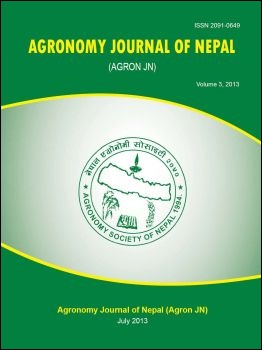Constraint and opportunity of raw jute production : A case study of eastern Terai, Nepal
DOI:
https://doi.org/10.3126/ajn.v3i0.9013Keywords:
cost of production, low price, production constraints, quality seed, raw juteAbstract
Area and production of raw jute has decreased, though there is a high demand of raw jute in the country. In order to assess production constraints, a survey was carried out in 2005/06 in Jhapa, Morang and Sunsari districts. The study revealed that unstable or low price of raw jute, unavailability of quality jute seed, limited irrigation water at sowing period, diseases complex (wilt), labor shortage during peak season, weed problem, lack of retting water/retting pond were the main constraints in jute production and processing. The study indicates that the maximum production cost has involved in fiber extraction (16.9%) and weeding (16.33%). Jute productivity ranged from 1788 to 2260 kg per hectare. JRO-524 variety of jute has been widely grown across the region due to its wider adaptability, high yield potential and quality fiber. Jute area has been replaced by sugarcane due to its high yield potential and high profit margin. It is observed that the cost of production of jute is high as compared to other crops in the season. Average cost of production of fiber was estimated to be Rs.1563/quintal. For the promotion of jute cultivation in the eastern Terai, it would be better to provide subsidies on seeds and fertilizer to jute growers as practiced in neighboring countries thereby profit margin becomes high and will encourage growers in producing more raw jute within the country for the fulfillment of raw jute requirement of local jute industries. Cost effective technologies have to be developed in jute production and processing aspects for lowering the production cost and increasing the profit margin. Popular genotypes JRO- 524 which was widely adopted needs to be recommended officially for the general cultivation in this region. Being an eco-friendly crop, promotion is required to adapt climate change effect and maintaining the soil properties in jute growing areas.
Agronomy Journal of Nepal (Agron JN) Vol. 3. 2013, Page 117-122
Downloads
Downloads
Published
How to Cite
Issue
Section
License
ASON permits for free use, distribution and reproduction in any medium if the original work is properly cited and not used for commercial purposes.




